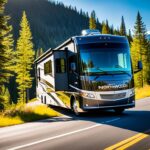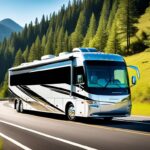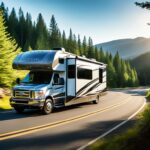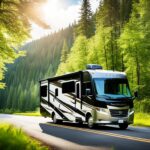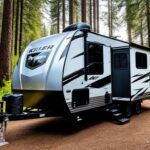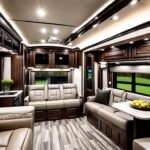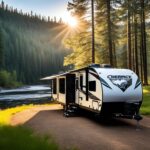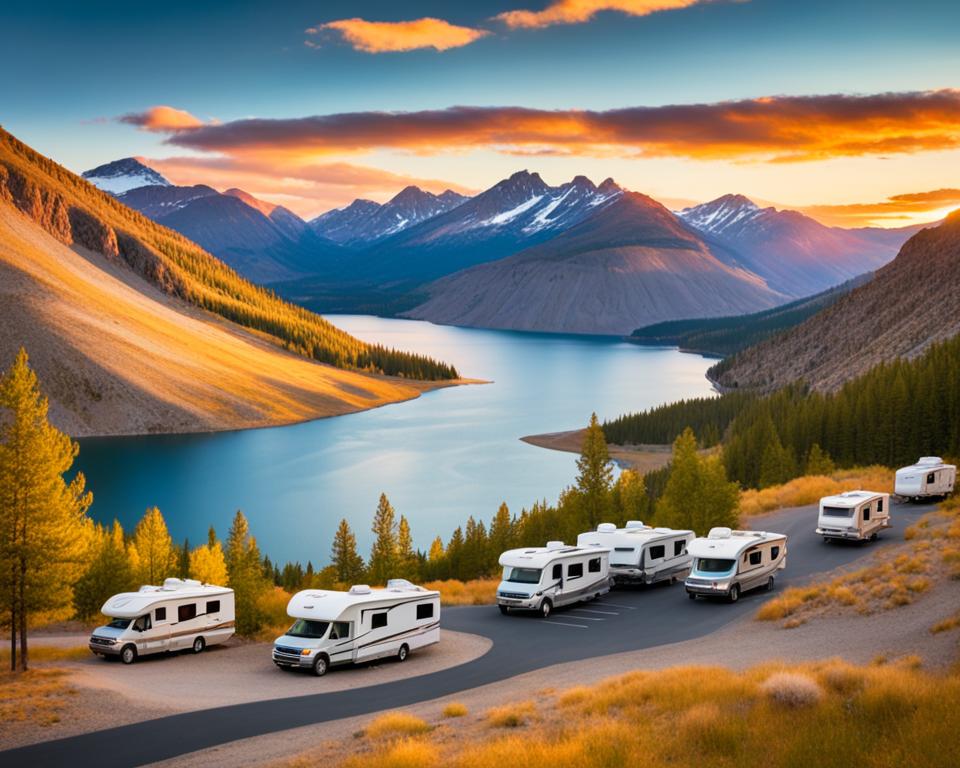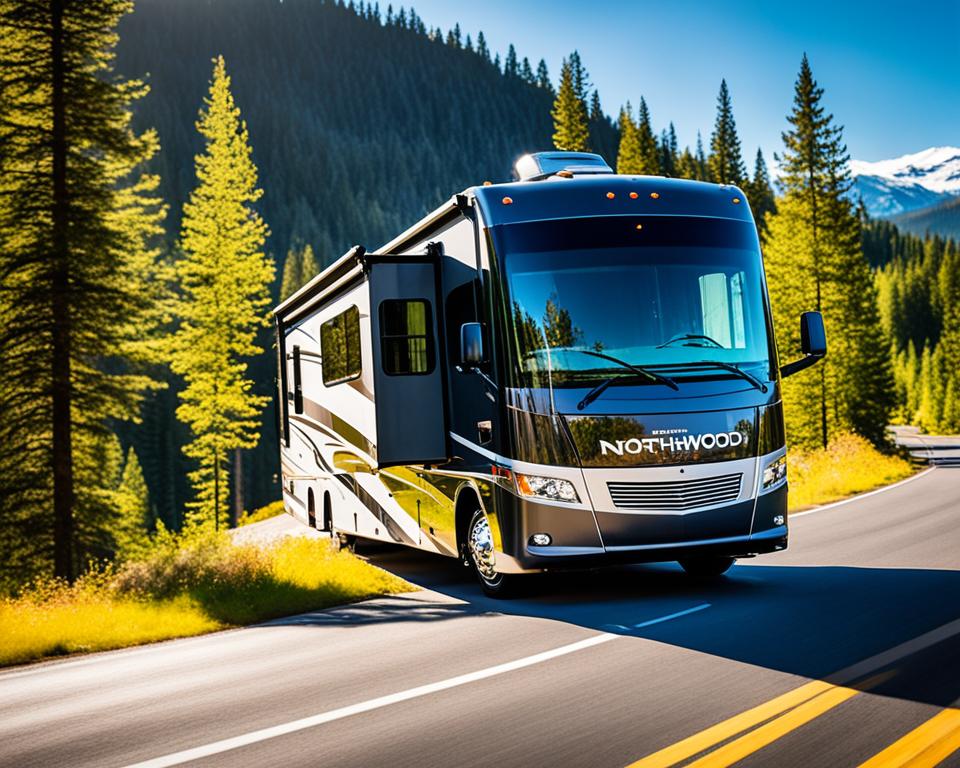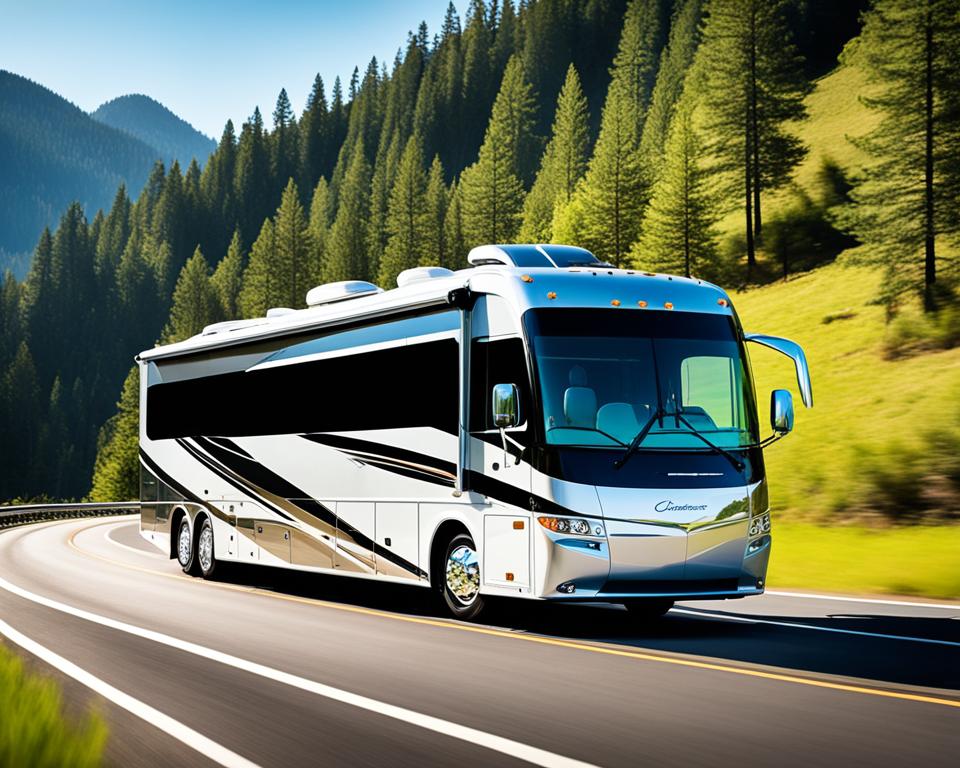Having an air conditioner in your recreational vehicle (RV) is essential for staying cool and comfortable during your travels. Whether you have a camper, a motorhome, or a travel trailer, a reliable RV air conditioner can make all the difference in your journey.
From portable RV AC units to rooftop RV AC installations, there are various options available to suit your needs. In this comprehensive guide, we will provide you with tips for maximizing the use of your RV air conditioner, as well as creative ways to stay cool without one. So, whether you’re embarking on a cross-country road trip or exploring national parks, this guide has got you covered.
Key Takeaways:
- Choose the best RV air conditioner for your needs, considering factors such as cooling capacity and energy efficiency.
- Properly power your RV air conditioner by using a generator or plugging into a 30 or 50 amp outlet with a surge guard for added protection.
- Maximize the efficiency of your RV air conditioner by drawing in outside air, keeping doors and windows closed, using LED lights, and using reflective vent insulation.
- Regularly maintain your RV air conditioner by keeping it on a low setting, cleaning the air filters, and cleaning rooftop AC units.
- If you don’t have an RV air conditioner, stay cool by parking in the shade, opening windows, using battery-powered fans, and cooking outside.
Now that you have an overview of what this guide has in store for you, let’s dive into the details of each section to ensure you have the best possible RV air conditioning experience.
Powering Your RV Air Conditioner
To ensure that your RV air conditioner operates correctly, you must power it adequately. For one air conditioner, you will need approximately 4,000 watts from a generator, and for two air conditioners, you will need 5,500 watts.
If you are not using a generator, make sure to plug into a 30 or 50 amp outlet. A 30 amp outlet is commonly found in older campgrounds and smaller RVs, while a 50 amp outlet is typically available in newer campgrounds and larger RVs.
It is also recommended to use a surge guard for your RV air conditioner. A surge guard will protect the compressor and other electrical parts of your RV from power surges and fluctuations, ensuring the longevity and proper functioning of your air conditioner.
With the right power requirements, outlet selection, and surge protection, you can enjoy reliable and efficient cooling in your RV, no matter the destination.
Maximizing Use of Your RV Air Conditioner
To get the most out of your RV air conditioner, there are several things you can do. Initially, open windows to allow cooler air from outside to circulate within your RV. If your air conditioner has the option to bring in outside air, using it can be a more energy-efficient option. Once your RV starts cooling down, close doors and windows to keep cold air inside. Use blinds, shades, or reflective vent insulation to prevent heat from entering your RV. Additionally, using LED lights instead of incandescent bulbs can reduce heat emission and help you stay cooler.
Making the Most of Natural Ventilation
To maximize RV air conditioner efficiency, take advantage of natural ventilation. On cooler days or during the evening, open windows and doors to allow fresh outside air to flow into your RV. This not only helps cool down the interior but also circulates stagnant air and eliminates odors. Proper ventilation can provide relief and reduce the strain on your air conditioner, promoting energy savings.
Sealing Your RV for Optimal Cooling
Once your air conditioner is turned on and starts cooling your RV, it’s crucial to create a sealed environment to retain the cool air. Close all doors and windows to minimize the exchange of air between the RV and the outside. This prevents warm air from infiltrating your living space and allows your air conditioner to work more efficiently. The fewer drafts and openings, the better your RV will stay cool.
Reflective Vent Insulation
Installing reflective vent insulation can significantly boost the efficiency of your RV air conditioner. This insulation helps to reduce heat transfer through the vents, preventing warm air from entering your RV and keeping cool air inside. Reflective vent insulation is an easy and cost-effective solution that can contribute to maintaining a comfortable temperature in your RV.
Efficient Lighting with LED Lights
Consider replacing traditional incandescent light bulbs in your RV with energy-efficient LED lights. LED lights produce less heat compared to incandescent bulbs, helping to keep the interior of your RV cooler. By using LED lights, you not only reduce heat emission but also conserve energy and extend the battery life of your RV, making it a win-win situation.
Closing Thoughts
Maximizing the use of your RV air conditioner is essential for optimal cooling and energy efficiency. By drawing in outside air, keeping doors and windows closed, using reflective vent insulation, and switching to LED lights, you can create a comfortable and cool RV interior, even during hot summer days. These simple steps will not only enhance your comfort but also contribute to a more sustainable and enjoyable RV experience.
Taking Care of Your RV Air Conditioner
To ensure that your RV air conditioner continues to function optimally, it requires regular maintenance and care. By following a few simple steps, you can extend the lifespan of your air conditioner and ensure that it operates efficiently throughout your travels.
Keep the Air Conditioner on a Low Setting
One of the key maintenance practices for your RV air conditioner is to keep it running on a low setting. Extreme temperatures can have a negative impact on the lifespan of the unit. By keeping the air conditioner on a lower setting, you not only save energy but also reduce the strain on the system.
Clean the Air Filters Regularly
Regularly cleaning the air filters is essential for maintaining the performance of your RV air conditioner. Over time, the filters can become clogged with dust, dirt, and other debris, hindering the airflow and reducing the cooling efficiency. To clean the air filters, simply remove the grill, shake out any debris, and rinse them with warm soapy water. Allow the filters to dry completely before reinstalling them.
Clean the Rooftop RV Air Conditioner
If you have a rooftop RV air conditioner, it is important to periodically clean the vents and ensure that they are clear of any debris. Leaves, twigs, and other outdoor elements can accumulate on the rooftop unit, obstructing the airflow and affecting its performance. Regularly inspect the vents and clean them as needed to promote proper airflow and cooling.
By incorporating these maintenance practices into your routine, you can keep your RV air conditioner running smoothly and efficiently. Taking care of your air conditioner will not only provide you with a comfortable living environment during your travels but also help prevent costly repairs or replacements in the long run.
Cooling Tips Without an RV Air Conditioner
If you find yourself without access to an RV air conditioner, don’t worry! There are still simple and effective ways to stay cool during your travels. By following these tips, you can beat the heat and enjoy your journey without the need for an air conditioner.
Park in the Shade
One of the easiest ways to keep your RV cool is by parking in the shade. Look for shaded areas or use awnings or canopies to create a shaded spot. This will help reduce sun exposure and minimize heat buildup inside your RV.
Open Windows
Allowing fresh air to circulate within your RV can make a significant difference in temperature. Open windows strategically to create cross ventilation and let the cool breeze in. This will help create a more comfortable environment inside your RV.
Utilize Battery-Powered Fans
A battery-powered fan can be a lifesaver in hot weather. Place the fan near open windows or facing towards you to create a cooling effect. The gentle breeze will provide relief and make the heat more bearable.
Cook Outside
Using cooking appliances inside your RV can generate a significant amount of heat. Instead, plan your meals to be cooked outside. Utilize portable grills or camping stoves to cook your meals in the fresh air. Not only will this keep the heat outside, but it will also add an element of fun to your camping experience.
By taking advantage of these cooling tips, you can stay comfortable even without an RV air conditioner. Park in the shade, open windows, use a battery-powered fan, and cook outside to beat the heat and make the most of your journey.
Understanding RV Air Conditioner Performance
It’s important to understand the performance limitations of your RV air conditioner. The cooling capacity of an RV air conditioner can significantly impact your comfort while on the road. To understand how well your air conditioner can cool your RV, you need to consider the air conditioner’s cooling capacity and various performance factors.
A typical rooftop AC unit in an RV can cool the inside air up to 20 degrees below the outside air temperature. This 20-degree temperature difference is a general guideline, but it’s important to note that it may vary depending on several factors.
The primary factors that influence the performance of an RV air conditioner include:
- Outside humidity levels
- Outside temperature
- The condition and maintenance of the AC unit
Higher outside humidity levels can decrease the effectiveness of the air conditioner’s cooling. Similarly, extremely high outside temperatures can put a strain on the AC unit and affect its cooling capacity. Regular maintenance, including cleaning and servicing the AC unit, is essential to ensure optimal performance.
When relying on your RV air conditioner to keep you cool during hot weather, it’s vital to be aware of these performance factors. Understanding them will help you manage your expectations and take the necessary steps to maximize your air conditioner’s effectiveness in creating a comfortable indoor climate inside your RV.
Remember, the cooling capacity of your RV air conditioner, along with the external conditions and the AC unit’s condition, will determine how well it can cool the interior. By being informed, you can make informed decisions to create a more comfortable environment in your RV.
Heating and Cooling Options for Motorized RVs
When it comes to motorized RVs, choosing the right heating and cooling options is essential for a comfortable and enjoyable journey. Motorized RVs typically utilize rooftop air conditioners to provide cooling during warm weather. These air conditioners can operate through ducts for even air distribution or by blowing air directly into the RV.
Larger motorized RVs often feature ducted air conditioning systems, which allow for consistent airflow throughout the vehicle. On the other hand, smaller motorized RVs may rely on the direct blowing method, delivering cool air directly into the living space. Both options offer effective cooling solutions based on the size and layout of your RV.
For heating purposes, motorized RVs have two primary options: heat pumps and propane furnaces. Heat pumps work best in temperatures above 45 degrees Fahrenheit, utilizing the transfer of warm air from the outside to the inside of the RV. They are energy-efficient and effective during milder weather conditions.
On the other hand, if you plan to travel to colder areas, a propane furnace is a suitable choice. Propane furnaces provide consistent and reliable heating in low temperatures. They use propane as a fuel source and are designed to keep you warm and cozy even during chilly nights.
When selecting the heating and cooling options for your motorized RV, consider your travel destinations and the climate you will encounter. This will help you choose the most appropriate system to keep your RV comfortable in all weather conditions.
Motorized RV Heating and Cooling Options:
| Heating | Cooling | |
|---|---|---|
| Option 1 | Heat Pump | Rooftop Air Conditioner |
| Option 2 | Propane Furnace | Rooftop Air Conditioner |
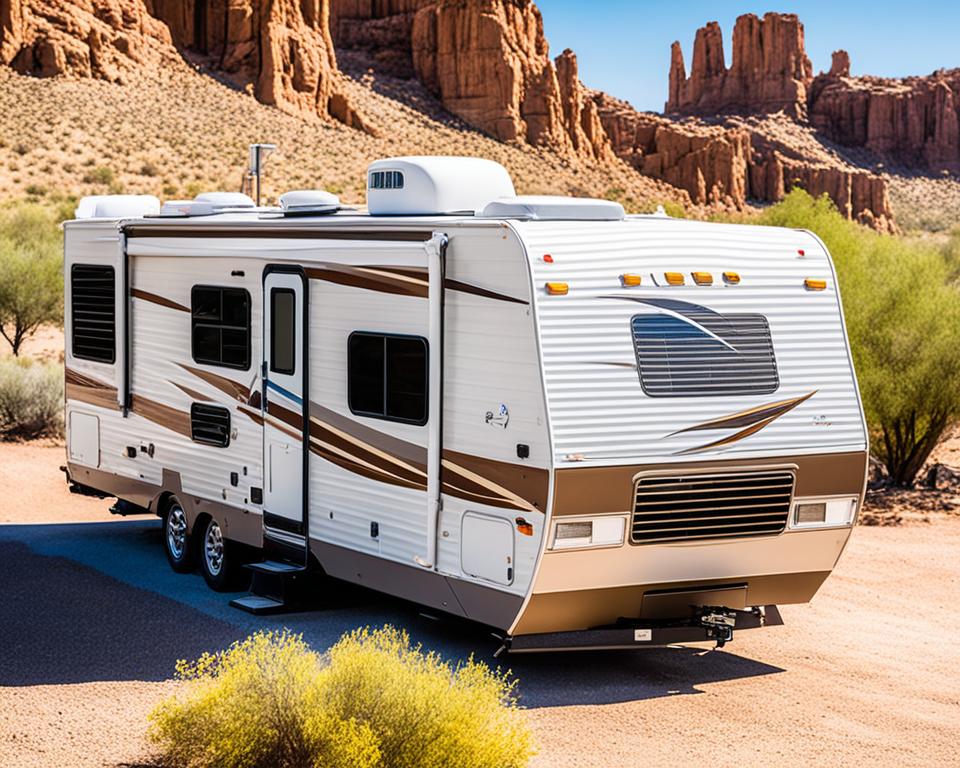
Ensure that your motorized RV is equipped with the appropriate heating and cooling systems to keep you comfortable throughout your travels. Whether it be a rooftop air conditioner, ducted air conditioning, heat pump, or propane furnace, choosing the right options will enhance your RV experience.
Thermostat and Climate Control in RVs
Many RVs are equipped with a thermostat or climate control panel that allows for easy temperature adjustment throughout the RV. This system is often divided into two zones, the living room area and the bedroom area.
The RV thermostat provides precise control over the temperature in each zone, giving you the flexibility to create a comfortable environment tailored to your preferences. With zone temperature control, you can choose to heat or cool specific areas of your RV, improving energy efficiency and optimizing comfort.
Whether you want to warm up the living room for a cozy evening or cool down the bedroom for a restful night’s sleep, the RV thermostat makes it simple to set the ideal temperature in each zone.
Additionally, some RV thermostats offer advanced features such as programmable schedules, allowing you to automatically adjust the temperature based on your daily routine. This ensures that your RV is always at the perfect temperature when you need it, without wasting energy when you don’t.
“Having a thermostat in your RV makes it easy to maintain a comfortable living environment, no matter the weather outside. With separate temperature control for different zones, you can customize the climate to suit your preferences.”
With the climate control panel, you have quick access to all the necessary settings, making it convenient to adjust the temperature, fan speed, and other climate control options. Some climate control panels even come with digital displays, allowing for precise temperature monitoring and control.
Having a thermostat and climate control panel in your RV enhances your overall comfort and convenience, ensuring that you can enjoy your travels in the perfect climate.
Benefits of RV Thermostat and Climate Control:
- Easy temperature adjustment throughout the RV
- Zone temperature control for improved energy efficiency
- Precise temperature control in different areas
- Programmable schedules for automated temperature adjustments
- Quick access to settings with a climate control panel
With an RV thermostat and climate control panel, you have the power to create a comfortable and personalized environment in your RV, no matter where your adventures take you.
HVAC Options for Trailers
Trailers, which include certain types of RVs, mobile homes, and offices, have different HVAC options compared to motorized RVs. When it comes to cooling, trailers have a variety of options to choose from.
- Window Units: Window units are a popular choice for trailers. They are easy to install and provide cooling for individual rooms or areas.
- Mini Split Systems: Mini split systems offer both cooling and heating capabilities. They consist of an outdoor unit and one or more indoor units, allowing you to control the temperature in different areas of your trailer.
- Packaged Air Conditioners: Packaged air conditioners are self-contained units that can be installed on the roof or exterior of a trailer. They are efficient and provide cooling for the entire trailer.
- Ducted Systems: Ducted systems use a network of ducts to distribute cool air throughout the trailer. They are ideal for larger trailers and provide consistent cooling.
When it comes to heating options, trailers also offer a range of choices:
- Furnaces: Furnaces are commonly used in trailers for heating purposes. They use propane or natural gas to provide heat and are effective in colder climates.
- Electric Heaters: Electric heaters are another option for heating your trailer. They are easy to install and provide warmth without the need for propane or natural gas.
- Space Heaters: Space heaters are portable heating devices that can be used in trailers. They are convenient and provide localized heat.
When selecting an HVAC system for your trailer, it’s important to consider the specific needs of your trailer and the climate you’ll be traveling in. Choose a system that provides efficient cooling and heating to keep your trailer comfortable throughout your journey.
Maximizing Cooling and Heating Efficiency in RVs and Trailers
When it comes to keeping your RV or trailer at the optimal temperature, maximizing cooling and heating efficiency is key. By implementing a few simple strategies, you can ensure that your HVAC system runs smoothly and efficiently, keeping you comfortable throughout your journey.
Proper Insulation
One effective way to maximize cooling and heating efficiency in your RV or trailer is by properly insulating it. Insulation helps to reduce heat transfer, keeping the interior cooler in hot weather and warmer in cold weather. Consider adding insulation to the walls, floors, and ceiling to minimize the impact of external temperatures on the interior climate.
Close Vents in Unused Areas
Another way to improve HVAC efficiency is by closing vents in areas of your RV or trailer that are not currently in use. By doing so, you can redirect airflow to the rooms or areas where you actually need it, ensuring more effective cooling or heating. This helps to maximize energy usage and avoid wasting conditioned air in unused spaces.
Park in the Shade
Parking your RV or trailer in the shade can have a significant impact on maintaining a comfortable temperature inside. By avoiding direct sunlight, you can naturally reduce heat buildup, making it easier for your HVAC system to cool or heat the interior. Whenever possible, choose shaded parking spots to optimize the cooling and heating efficiency of your vehicle.
Temperature Sensor Placement
The placement of your temperature sensor is crucial for accurate readings and optimal HVAC performance. Make sure that the sensor is positioned in an area that represents the average temperature of the RV or trailer, avoiding locations that could skew the readings. It’s recommended to place the sensor away from direct sunlight, heat sources, and drafts to ensure it provides reliable temperature measurements.
By implementing these strategies, you can maximize the cooling and heating efficiency of your RV or trailer, ensuring a comfortable environment no matter the weather outside. Taking the time to properly insulate, close vents in unused areas, park in the shade, and position the temperature sensor correctly can significantly improve your HVAC system’s performance.
Conclusion
Having a properly functioning air conditioner is essential for staying comfortable during your RV adventures. This comprehensive recreational vehicle air conditioner guide has provided you with valuable tips and insights to maximize the use of your RV air conditioner.
By following these tips for RV air conditioning, such as drawing in outside air, keeping doors and windows closed, using LED lights, and maintaining your RV air conditioner, you can ensure optimal performance and energy efficiency.
However, if you find yourself without a recreational vehicle air conditioner, don’t worry! We’ve also shared creative ways to stay cool without an RV AC unit, including parking in the shade, opening windows, using battery-powered fans, and cooking outside.
Whether you have an RV air conditioner or not, these tips will help you beat the heat and stay comfortable during your travels. So get ready to hit the road and enjoy a cool and refreshing journey in your RV!
FAQ
What power source do I need for my RV air conditioner?
For one air conditioner, you will need approximately 4,000 watts from a generator, and for two air conditioners, you will need 5500 watts. If you are not using a generator, make sure to plug into a 30 or 50 amp outlet.
How can I maximize the efficiency of my RV air conditioner?
Open windows to allow cooler air from outside to circulate within your RV. If your air conditioner has the option to bring in outside air, use it for energy efficiency. Once your RV starts cooling down, close doors and windows to keep cold air inside. Use blinds, shades, or reflective vent insulation to prevent heat from entering. Using LED lights instead of incandescent bulbs can also reduce heat emission.
How should I take care of my RV air conditioner?
Keep the air conditioner on a low setting to avoid extreme temperatures that can impact its lifespan. Regularly clean the air filters by removing the grill and shaking out debris or rinsing with warm soapy water. For rooftop RV air conditioners, make sure the vents are clear and clean.
What can I do to stay cool in my RV without an air conditioner?
Park in the shade to reduce sun exposure and heat buildup. Open windows to let fresh air circulate. Consider using a battery-powered fan to create airflow. Cook outside instead of using the oven, toaster, and microwave during the day to avoid heat buildup.
How effective is an RV air conditioner in cooling the interior?
Generally, a rooftop AC unit can cool the inside air up to 20 degrees below the outside air temperature. Factors such as outside humidity, temperature, and AC unit condition can impact cooling effectiveness.
What are the heating and cooling options for motorized RVs?
Motorized RVs typically use rooftop air conditioners for cooling. They can work through ducts or by blowing air directly. Larger RVs often have ducts for even air distribution, while smaller ones rely on direct air blowing. For heating, motorized RVs can use a heat pump or a propane furnace.
How can I control the temperature in different areas of my RV?
Many RVs have a thermostat or climate control panel that allows for easy temperature adjustment throughout the RV. This system is often divided into two zones, such as the living room area and the bedroom area, enabling zone temperature control.
What HVAC options are available for trailers?
Trailers can use window units, mini split systems, or packaged air conditioners for cooling. Ducted systems may also be installed for efficient cooling. Heating options for trailers include furnaces, electric heaters, and space heaters.
How can I maximize cooling and heating efficiency in my RV or trailer?
Properly insulate your RV or trailer to reduce heat transfer. Close vents in areas not in use to direct airflow to desired areas. Park in the shade to naturally reduce heat buildup. Check the placement of the temperature sensor for accurate readings.



